Research on Panorama Generation from a Multi-Camera System by Object-Distance Estimation
Abstract
:1. Introduction
- (1)
- In contrast to expensive panoramic camera systems that rely on professional cameras, a low-cost panoramic camera system is developed by a combination of eight low-cost web cameras in this paper.
- (2)
- An inverse rigorous panoramic imaging model is derived completely based on the pre-calibration of the inner orientation elements, distortion parameters of each camera, and the relative orientation relationships between cameras.
- (3)
- A scheme is proposed to estimate object-distance information within a surrounding scene. By expending the traditional Vertical Line Locus (VLL) object-based image matching algorithm [29], a panoramic Vertical Line Locus algorithm called PVLL is proposed to derive the optimized object-distance grids.
2. Related Work
2.1. Feature Point-Based Panoramic Imaging Method
2.2. Traditional Panoramic Imaging Model Based Method
3. Proposed Method
3.1. Overview of the Panoramic System
3.2. Proposed Inverse Panoramic Imaging Model
3.2.1. Relative Orientation between a Camera and the Panoramic Camera
3.2.2. Inverse Panoramic Imaging Model
3.3. Object-Distance Estimation Algorithm
3.3.1. Generation Algorithm of Pyramid Grids in Overlapping Regions
3.3.2. Estimation of Object-Distance Pyramid Maps in Overlapping Regions
- (1)
- Estimation of Candidate Object-Distance
| Algorithm 1: Solution of Projected Radius List |
| Input: , , , , , Output: 1: , , 2: 3: repeat 4: 5: if then 6: , 7: end if 8: 9: until Output: |
- (2)
- Panoramic Vertical Line Locus Algorithm
3.4. Object-Distance Interpolation Method in the Non-Overlapping Regions
4. Experimental Results
4.1. Calibration of the Panoramic Camera
4.2. Visualized Analysis
4.3. Quantitative Analysis
- (1)
- Each pixel within every overlapping region of a panoramic image was individually projected onto two overlapping original images captured by adjacent cameras, and the grayscale value of the projection points was obtained. In this way, two panoramic image patches were generated for each overlapping region, as shown in Figure 13.
- (2)
- The SIFT [34] feature points were then extracted and matched for each pair of panoramic image patches. The average Euclidean distance was then computed between corresponding feature points in every pair of panoramic image patches. In addition, the parameters of the Structural Similarity Index (SSIM) [31], Peak Signal-to-Noise Ratio (PSNR) [35], Normalized Cross-Correlation (NCC) coefficients, and Stitched Image Quality Evaluator (SIQE) [36] were determined to quantify the dissimilarities between each pair of panoramic image patches. The Root Mean Square Error (RMSE), average SSIM, average PSNR, and average NCC are further computed based on the average Euclidean distances, SSIM values, PSNR values, NCC coefficients, and SIQE respectively, obtained from the dataset of 160 panoramas.
- (3)
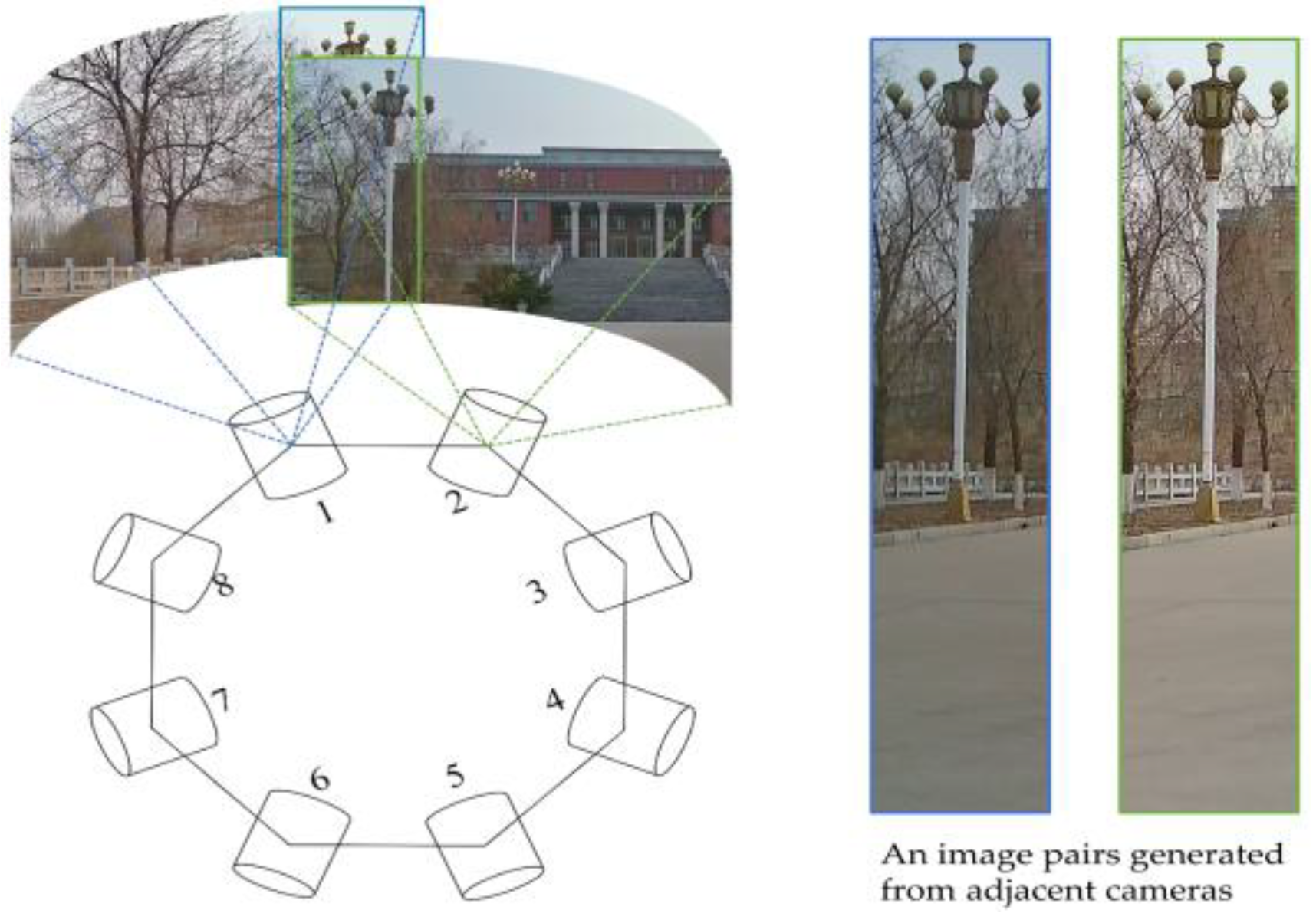
5. Conclusions and Future Work
Author Contributions
Funding
Institutional Review Board Statement
Informed Consent Statement
Data Availability Statement
Conflicts of Interest
References
- Kao, S.T.; Ho, M.T. Ball-Catching System Using Image Processing and an Omni-Directional Wheeled Mobile Robot. Sensors 2021, 21, 3208. [Google Scholar] [CrossRef] [PubMed]
- Wu, F.; Song, H.; Dai, Z.; Wang, W.; Li, J. Multi-camera traffic scene mosaic based on camera calibration. IET Comput. Vis. 2021, 15, 47–59. [Google Scholar] [CrossRef]
- Krishnakumar, K.; Gandhi, S.I. Video stitching using interacting multiple model based feature tracking. Multimed. Tools Appl. 2018, 78, 1375–1397. [Google Scholar] [CrossRef]
- Qu, Z.; Wang, T.; An, S.; Liu, L. Image seamless stitching and straightening based on the image block. IET Image Process. 2018, 12, 1361–1369. [Google Scholar] [CrossRef]
- Li, L.; Yao, J.; Xie, R.; Xia, M.; Zhang, W. A Unified Framework for Street-View Panorama Stitching. Sensors 2016, 17, 1. [Google Scholar] [CrossRef]
- Wenbo, J.; Xuefeng, G.; Bingkun, H.; Shitao, L.; Hongyang, Y. Expansion of Conical Catadioptric Panoramic Image of Inner Surface of Cylindrical Objects. Acta Opt. Sin. 2021, 41, 0311002. [Google Scholar] [CrossRef]
- Amani, A.; Bai, J.; Huang, X. Dual-view catadioptric panoramic system based on even aspheric elements. Appl. Opt. 2020, 59, 7630. [Google Scholar] [CrossRef]
- Baskurt, D.O.; Bastanlar, Y.; Cetin, Y.Y. Catadioptric hyperspectral imaging, an unmixing approach. IET Comput. Vis. 2020, 14, 493–504. [Google Scholar] [CrossRef]
- Ko, Y.J.; Yi, S.Y. Catadioptric Imaging System with a Hybrid Hyperbolic Reflector for Vehicle Around-View Monitoring. J. Math. Imaging Vis. 2017, 60, 503–511. [Google Scholar] [CrossRef]
- Khoramshahi, E.; Campos, M.; Tommaselli, A.; Vilijanen, N.; Mielonen, T.; Kaartinen, H.; Kukko, A.; Honkavaara, E. Accurate Calibration Scheme for a Multi-Camera Mobile Mapping System. Remote Sens. 2019, 11, 2778. [Google Scholar] [CrossRef]
- Zhang, Y.; Huang, F. Panoramic Visual SLAM Technology for Spherical Images. Sensors 2021, 21, 705. [Google Scholar] [CrossRef] [PubMed]
- Buyuksalih, G.; Baskaraca, P.; Bayburt, S.; Buyuksalih, I.; Rahman, A.A. 3D city modelling of istanbul based on lidar 333 data and panoramic images—Issues and challenges. Int. Arch. Photogramm. Remote Sens. Spat. Inf. Sci. 2019, XLII-4/W12, 51–60. [Google Scholar] [CrossRef]
- Nespeca, R. Towards a 3D digital model for management and fruition of Ducal Palace at Urbino. An integrated survey with mobile mapping. Sci. Res. Inf. Technol. 2019, 8, 1–14. [Google Scholar] [CrossRef]
- Afifi, A.; Takada, C.; Yoshimura, Y.; Nakaguchi, T. Real-Time Expanded Field-of-View for Minimally Invasive Surgery Using Multi-Camera Visual Simultaneous Localization and Mapping. Sensors 2021, 21, 2106. [Google Scholar] [CrossRef] [PubMed]
- Hongxia, C.; Lijun, C.; Ning, W.; Tingting, L. Calibration Method with Implicit Constraints for Multi-View Combined Camera Using Automatic Coding of Marker Points. Chin. J. Lasers 2020, 47, 0110003. [Google Scholar] [CrossRef]
- Ke, X.; Huang, F.; Zhang, Y.; Tu, Z.; Song, W. 3D Scene Localization and Mapping Based on Omnidirectional SLAM. IOP Conf. Ser. Earth Environ. Sci. 2021, 783, 012143. [Google Scholar] [CrossRef]
- Ullah, H.; Zia, O.; Kim, J.H.; Han, K.; Lee, J.W. Automatic 360° Mono-Stereo Panorama Generation Using a Cost-Effective Multi-Camera System. Sensors 2020, 20, 3097. [Google Scholar] [CrossRef]
- Qu, Z.; Lin, S.P.; Ju, F.R.; Liu, L. The Improved Algorithm of Fast Panorama Stitching for Image Sequence and Reducing the Distortion Errors. Math. Probl. Eng. 2015, 2015, 428076. [Google Scholar] [CrossRef]
- Brown, M.; Lowe, D.G. Automatic Panoramic Image Stitching using Invariant Features. Int. J. Comput. Vis. 2006, 74, 59–73. [Google Scholar] [CrossRef]
- Alwan, M.G.; AL-Brazinji, S.M.; Mosslah, A.A. Automatic panoramic medical image stitching improvement based on feature-based approach. Period. Eng. Nat. Sci. 2022, 10, 155. [Google Scholar] [CrossRef]
- Zhu, J.T.; Gong, C.F.; Zhao, M.X.; Wang, L.; Luo, Y. Image mosaic algorithm based on pca-orb feature matching. Int. Arch. Photogramm. Remote Sens. Spat. Inf. Sci. 2020, XLII-3/W10, 83–89. [Google Scholar] [CrossRef]
- Hoang, V.D.; Tran, D.P.; Nhu, N.G.; Pham, T.A.; Pham, V.H. Deep Feature Extraction for Panoramic Image Stitching. In Intelligent Information and Database Systems; Springer: Berlin/Heidelberg, Germany, 2020; pp. 141–151. [Google Scholar] [CrossRef]
- Woo Park, K.; Shim, Y.J.; Jin Lee, M.; Ahn, H. Multi-Frame Based Homography Estimation for Video Stitching in Static Camera Environments. Sensors 2019, 20, 92. [Google Scholar] [CrossRef] [PubMed]
- Ji, S.; Shi, Y. Image matching and bundle adjustment using vehicle-based panoramic camera. Cehui Xuebao Acta Geod. Cartogr. Sin. 2013, 42, 94–100+107. Available online: https://api.semanticscholar.org/CorpusID:130900916 (accessed on 6 July 2021).
- Wang, X.; Li, D.; Zhang, G. Panoramic Stereo Imaging of a Bionic Compound-Eye Based on Binocular Vision. Sensors 2021, 21, 1944. [Google Scholar] [CrossRef] [PubMed]
- Sato, T.; Ikeda, S.; Yokoya, N. Extrinsic Camera Parameter Recovery from Multiple Image Sequences Captured by an Omni-Directional Multi-camera System. In Lecture Notes in Computer Science; Springer: Berlin/Heidelberg, Germany, 2004; pp. 326–340. [Google Scholar] [CrossRef]
- Lemaire, T.; Lacroix, S. SLAM with Panoramic Vision. J. Field Robot. 2007, 24, 91–111. [Google Scholar] [CrossRef]
- Shi, Y.; Ji, S.; Shi, Z.; Duan, Y.; Shibasaki, R. GPS-Supported Visual SLAM with a Rigorous Sensor Model for a Panoramic Camera in Outdoor Environments. Sensors 2012, 13, 119–136. [Google Scholar] [CrossRef]
- Linder, W. Digital Photogrammetry—A Practical Course; Springer: Berlin/Heidelberg, Germany, 2006. [Google Scholar]
- Lin, M.; Xu, G.; Ren, X.; Xu, K. Cylindrical panoramic image stitching method based on multi-cameras. In Proceedings of the 2015 IEEE International Conference on Cyber Technology in Automation, Control, and Intelligent Systems (CYBER), Shenyang, China, 8–12 June 2015; IEEE: New York, NY, USA, 2015; pp. 1091–1096. [Google Scholar] [CrossRef]
- Wang, Z.; Bovik, A.; Sheikh, H.; Simoncelli, E. Image quality assessment: From error visibility to structural similarity. IEEE Trans. Image Process. 2004, 13, 600–612. [Google Scholar] [CrossRef]
- Lepetit, V.; Moreno-Noguer, F.; Fua, P. EPnP: An Accurate O(n) Solution to the PnP Problem. Int. J. Comput. Vis. 2008, 81, 155–166. [Google Scholar] [CrossRef]
- Zhang, Z.Y. A flexible new technique for camera calibration. IEEE Trans. Pattern Anal. Mach. Intell. 2000, 22, 1330–1334. [Google Scholar] [CrossRef]
- Lowe, D.G. Distinctive Image Features from Scale-Invariant Keypoints. Int. J. Comput. Vis. 2004, 60, 91–110. [Google Scholar] [CrossRef]
- Horé, A.; Ziou, D. Image Quality Metrics: PSNR vs. SSIM. In Proceedings of the 2010 20th International Conference on Pattern Recognition, Istanbul, Turkey, 23–26 August 2010; pp. 2366–2369. [Google Scholar] [CrossRef]
- Madhusudana, P.C.; Soundararajan, R. Subjective and Objective Quality Assessment of Stitched Images for Virtual Reality. IEEE Trans. Image Process. 2019, 28, 5620–5635. [Google Scholar] [CrossRef] [PubMed]
- Madhusudana, P.C.; Soundararajan, R. Official Implementation of Stitched Image Quality Evaluator (SIQE). Available online: https://github.com/pavancm/Stitched-Image-Quality-Evaluator (accessed on 10 October 2023).
- Cheung, G.; Yang, L.; Tan, Z.; Huang, Z. A Content-aware Metric for Stitched Panoramic Image Quality Assessment. In Proceedings of the 2017 IEEE International Conference on Computer Vision Workshops (ICCVW), Venice, Italy, 22–29 October 2017; pp. 2487–2494. [Google Scholar] [CrossRef]
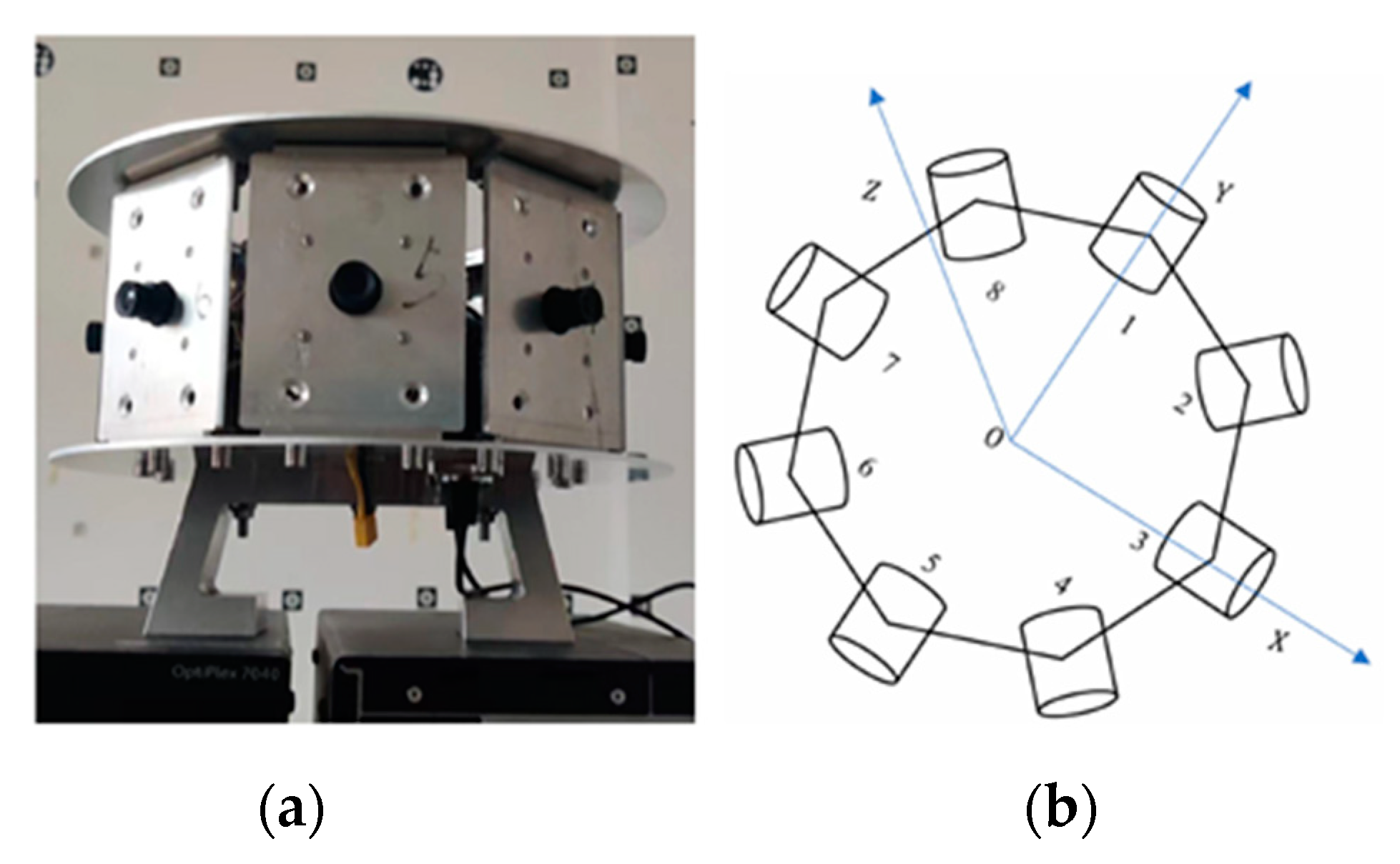
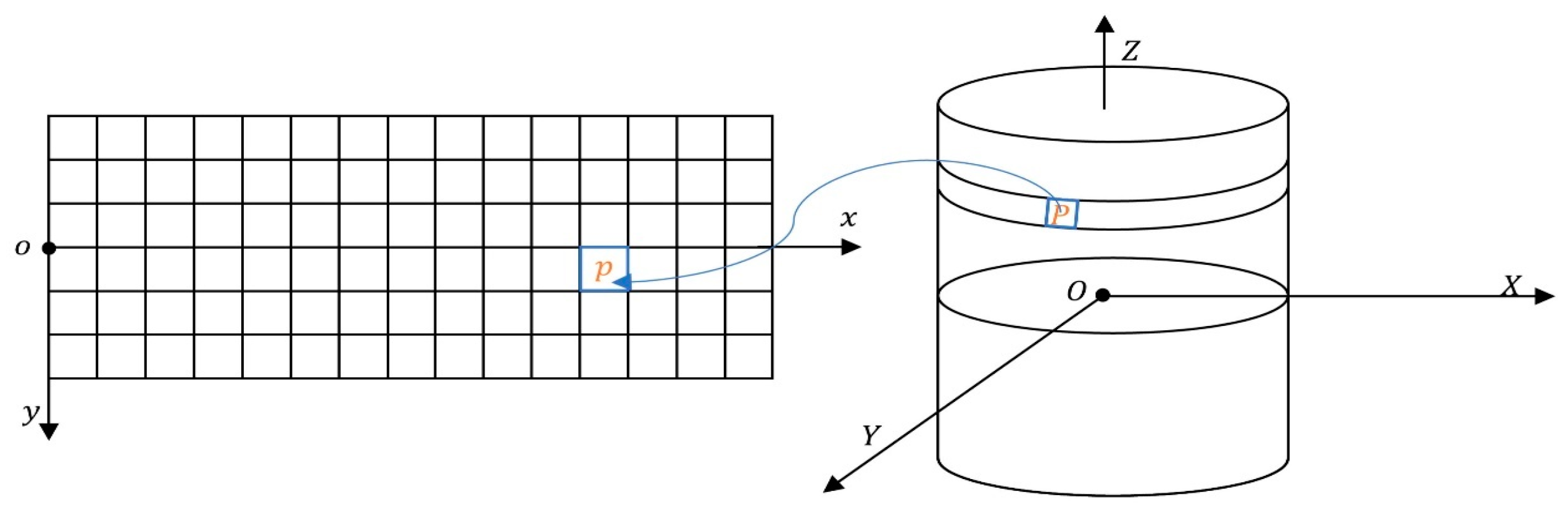

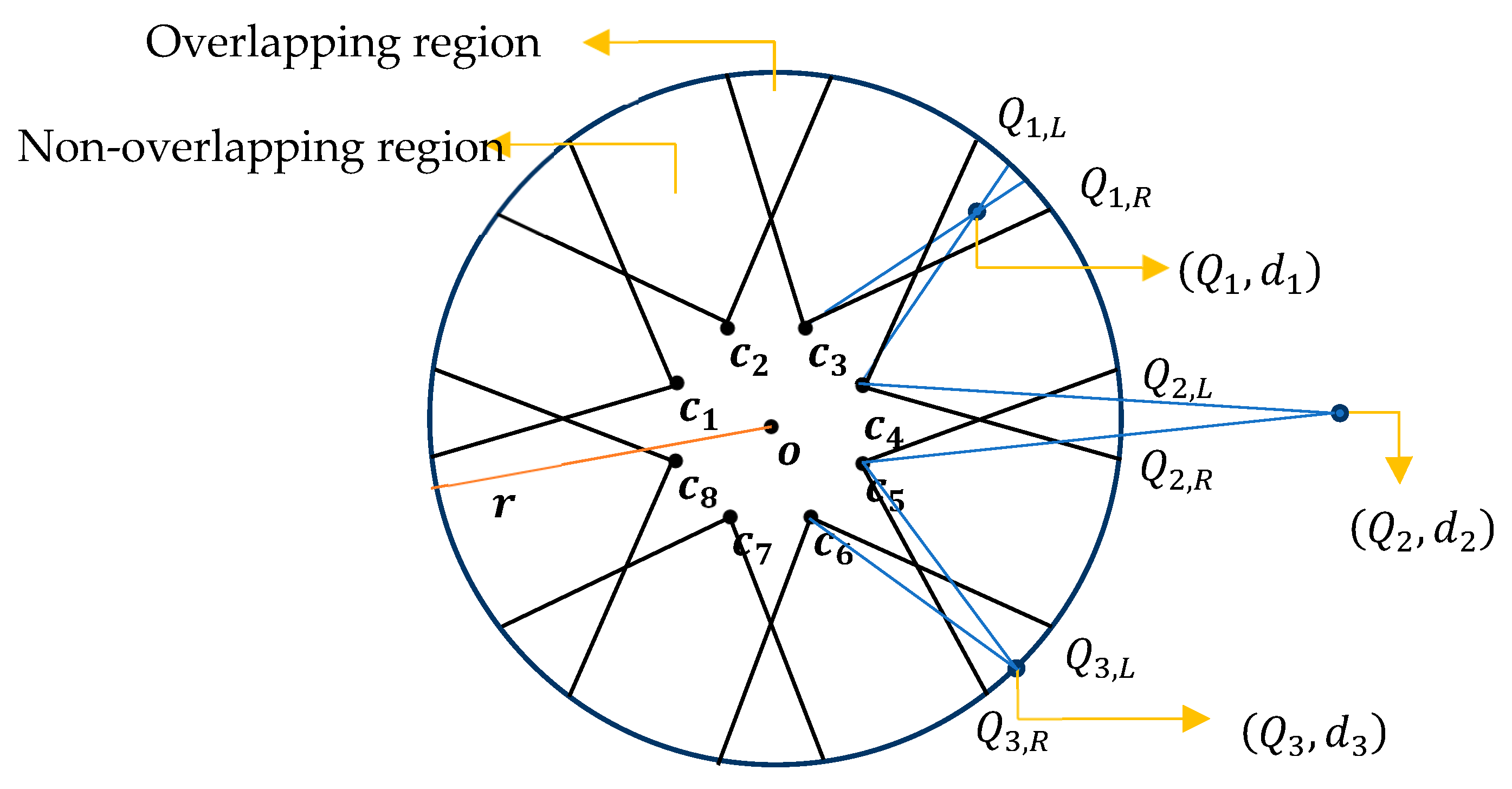
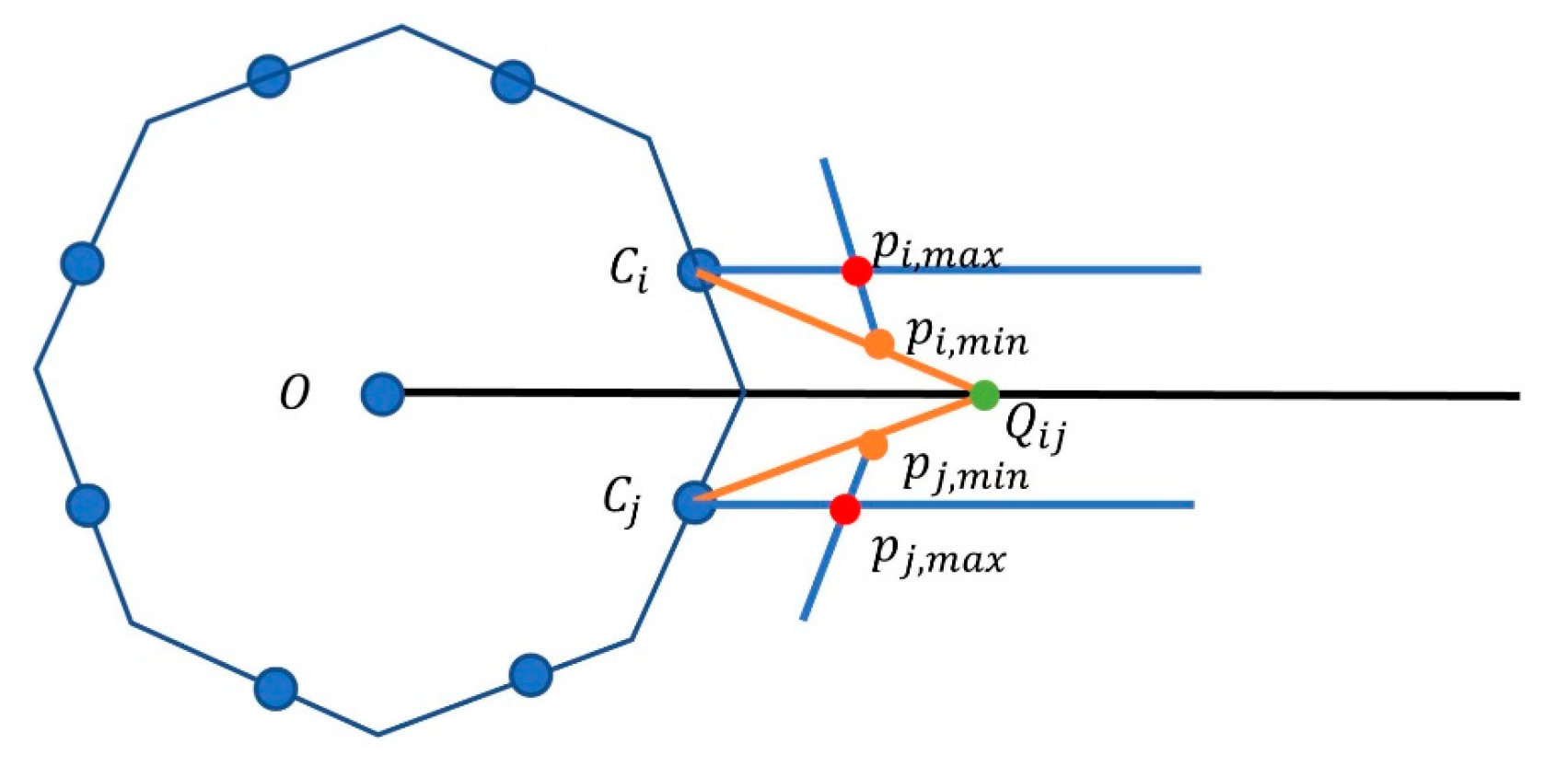
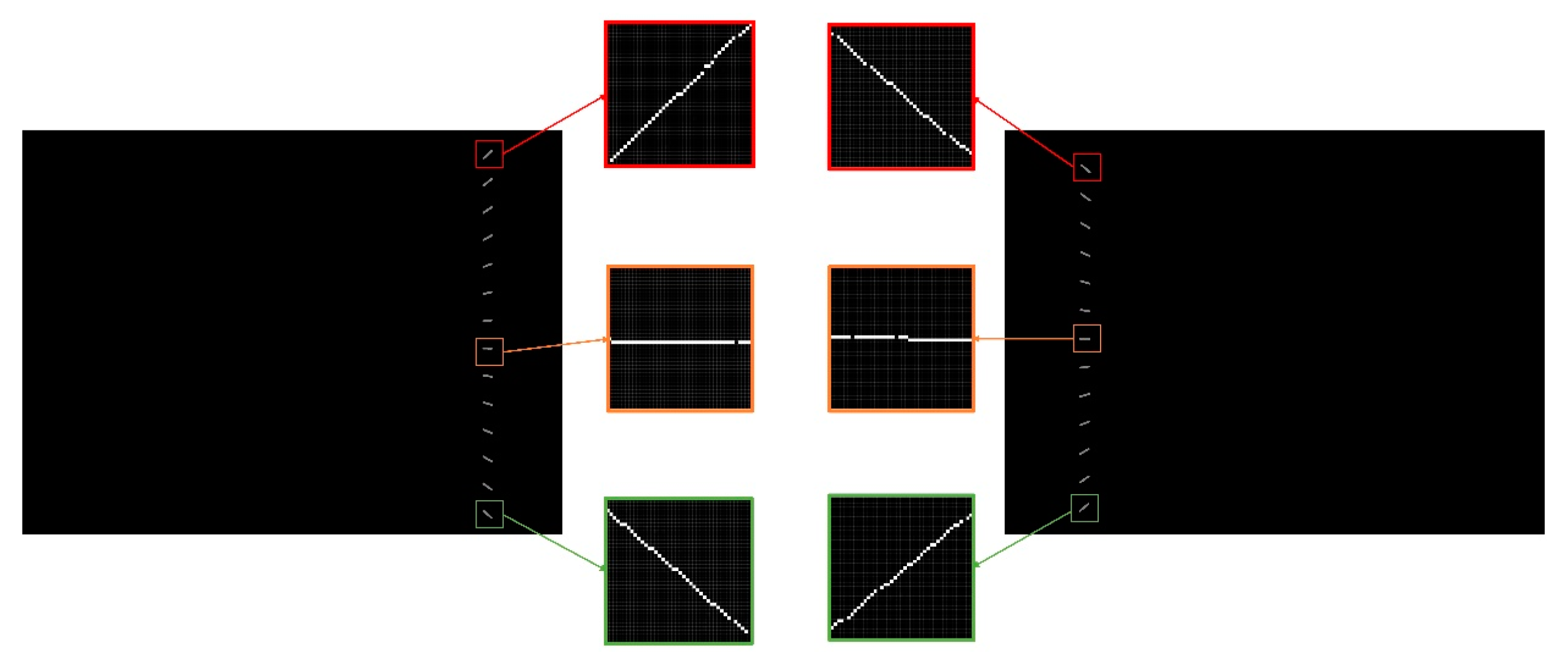
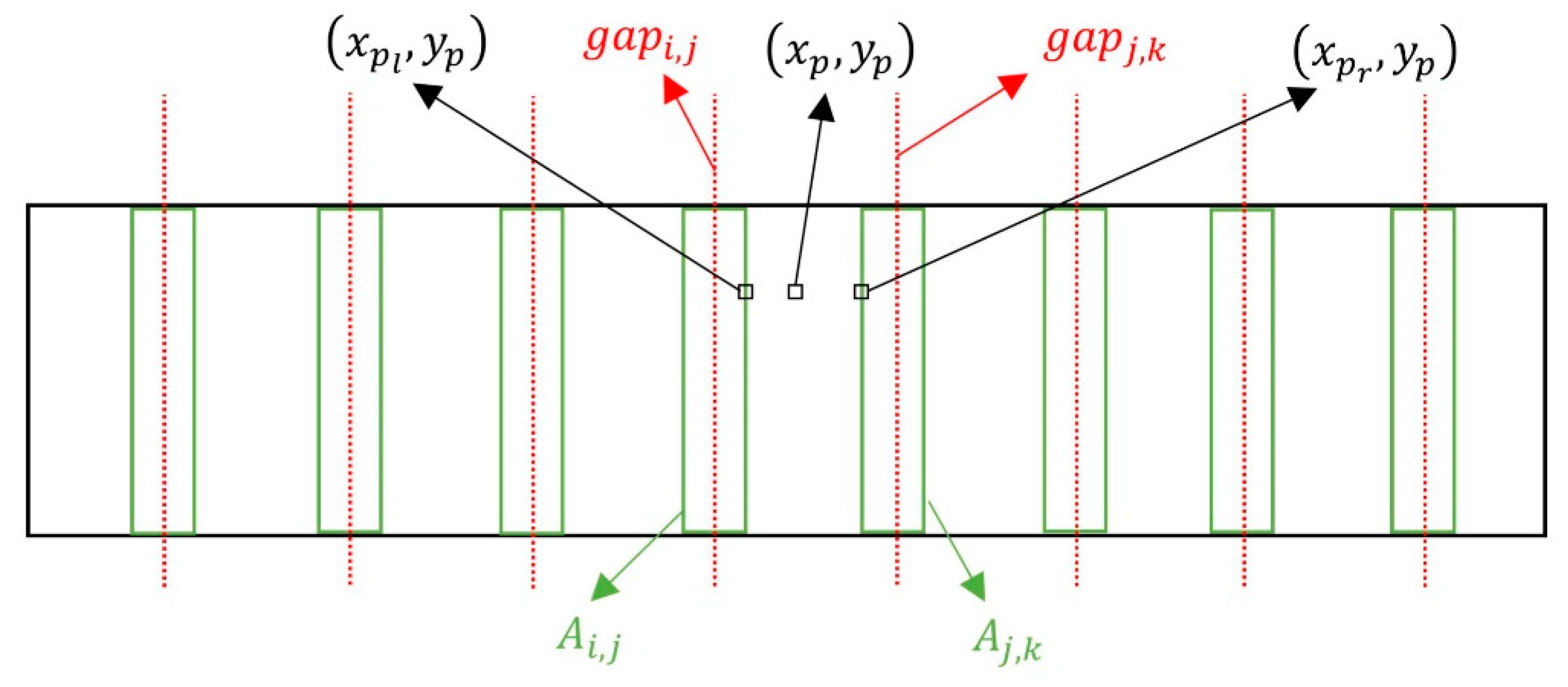
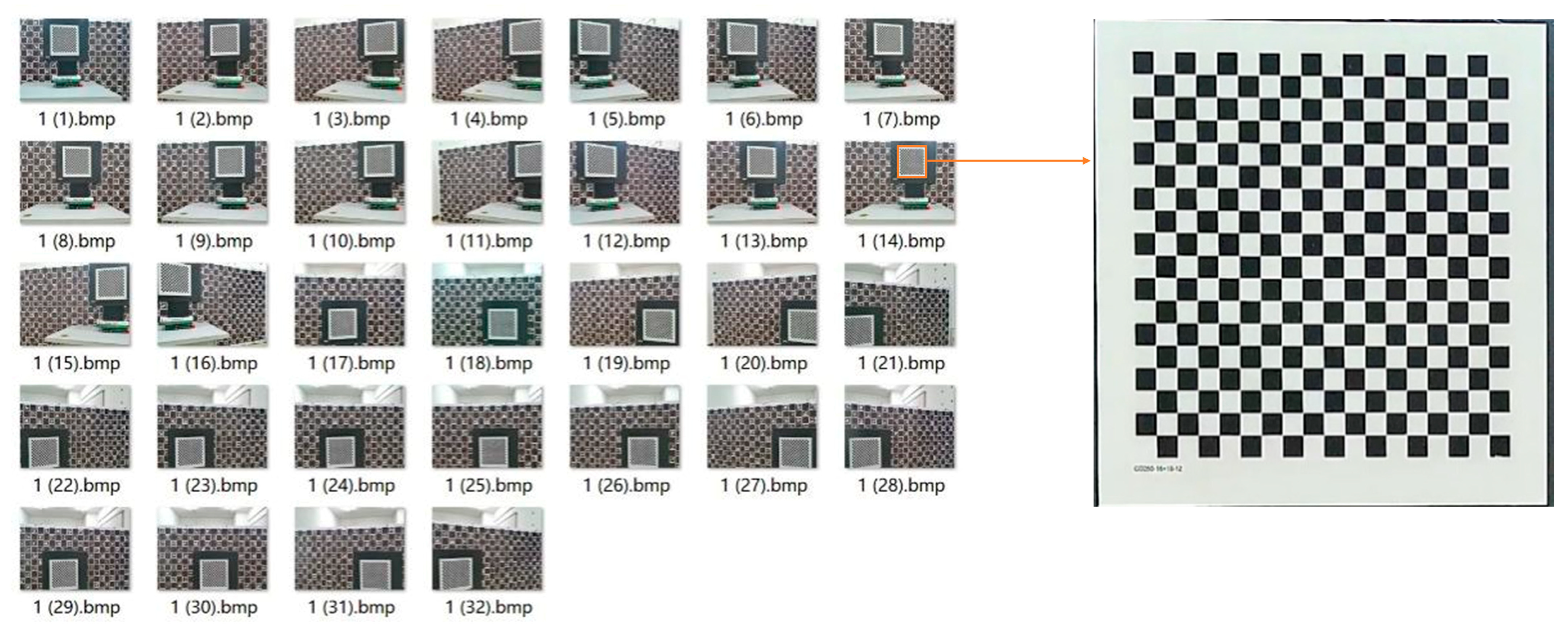
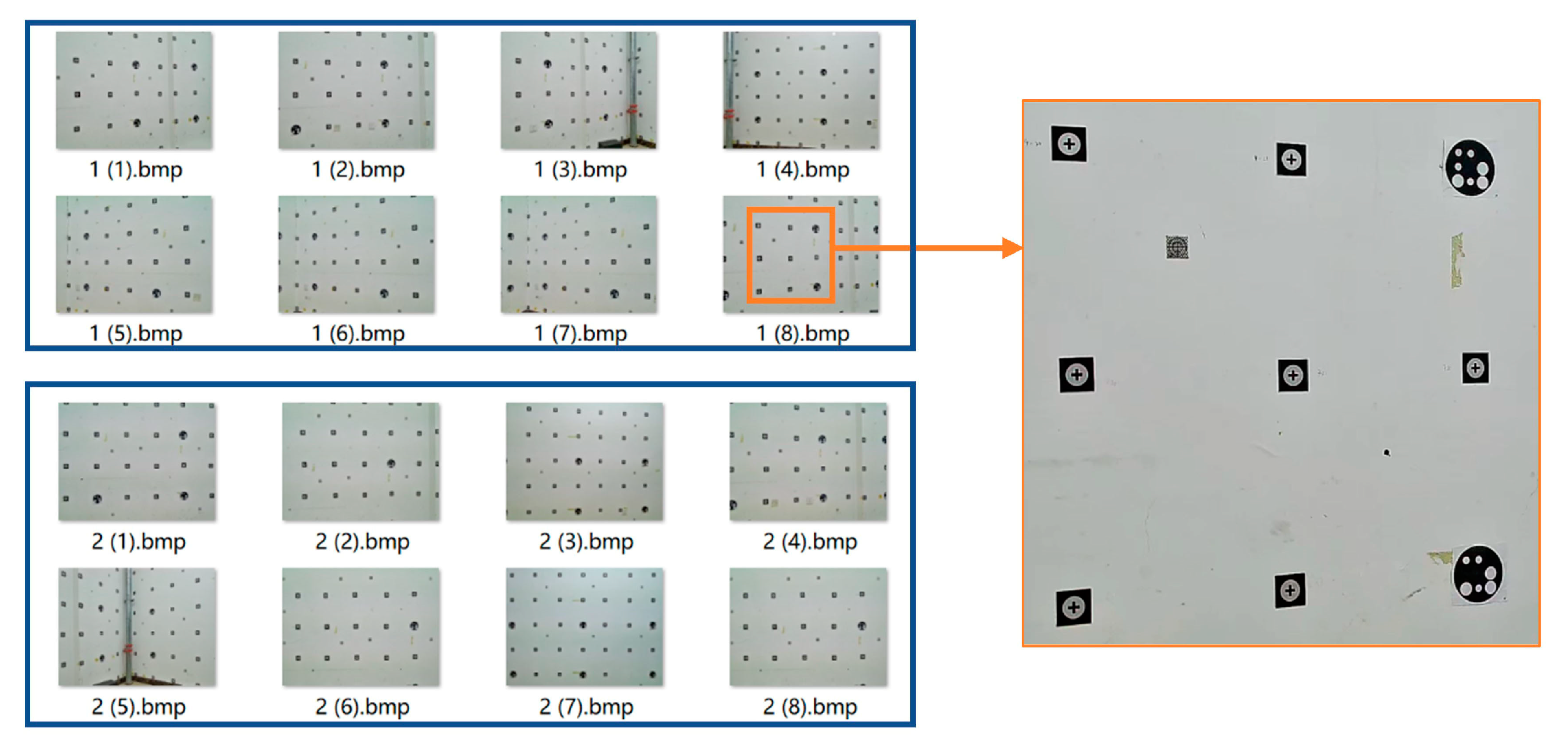
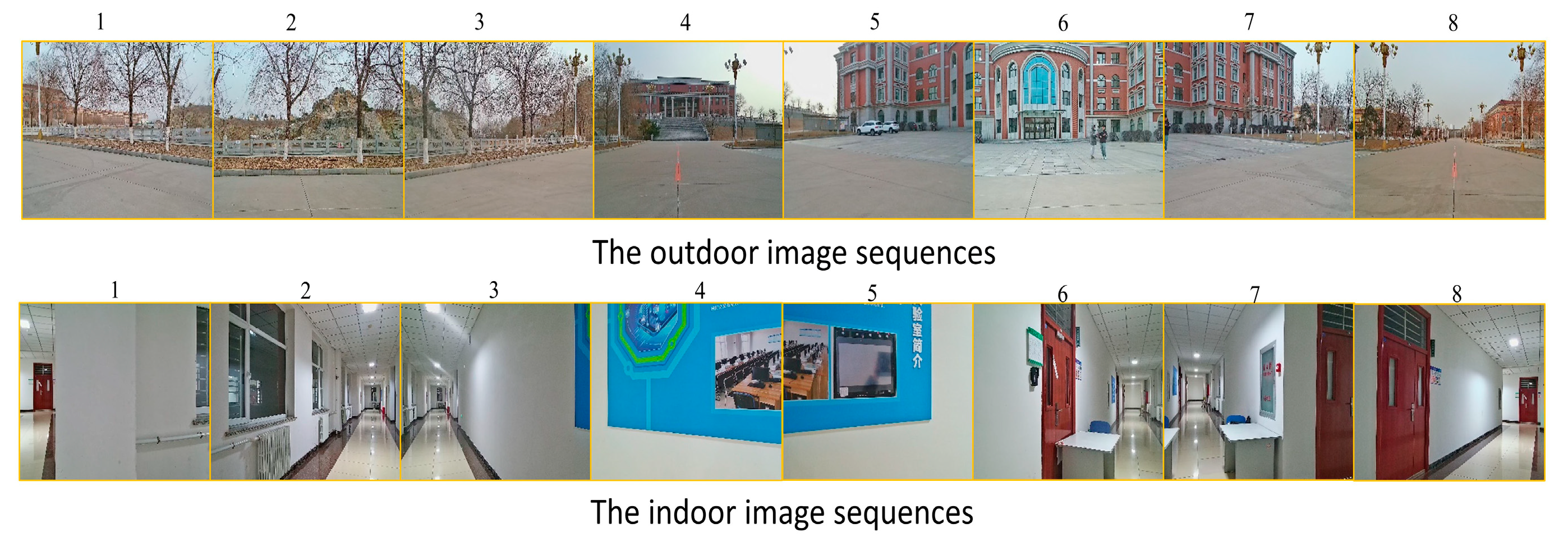


| Cam | ||||||
|---|---|---|---|---|---|---|
| 1 | 2.2782 | 2.4294 | 1.3259 | 0.9473 | 0.0281 | 0.0098 |
| 2 | 2.2684 | 2.4194 | 1.1535 | 1.0435 | 0.0255 | 0.0036 |
| 3 | 2.2729 | 2.4238 | 1.3974 | 1.0620 | 0.0257 | 0.0045 |
| 4 | 2.2759 | 2.4256 | 1.2523 | 1.0469 | 0.0285 | −0.0028 |
| 5 | 2.2601 | 2.4104 | 1.2447 | 9.4271 | 0.02718 | 0.0095 |
| 6 | 2.2744 | 2.4254 | 1.1629 | 1.0865 | 0.0253 | 0.0013 |
| 7 | 2.2761 | 2.4268 | 1.2567 | 1.0027 | 0.0253 | 0.0089 |
| 8 | 2.2731 | 2.4244 | 1.5161 | 1.0635 | 0.0306 | −0.0094 |
| Cam | α/rad | β/rad | γ/rad | X/cm | Y/cm | Z/cm |
|---|---|---|---|---|---|---|
| 1–2 | 0.0174 | 0.7814 | −0.0029 | 4.8081 | 0.0295 | −1.9565 |
| 1–3 | 0.0091 | 1.5850 | 0.0057 | 6.5616 | −0.0294 | 6.6810 |
| 1–4 | 0.0046 | 2.3532 | 0.0038 | 4.8170 | 0.0683 | −11.5291 |
| 1–5 | −0.0205 | −3.1253 | −0.0108 | −0.2132 | 0.1015 | −13.3953 |
| 1–6 | −0.0140 | −2.3357 | −0.0212 | −4.7553 | 0.0871 | −11.2954 |
| 1–7 | −0.0011 | −1.5729 | −0.0238 | −6.8198 | 0.0953 | −6.7039 |
| 1–8 | 0.0105 | −0.7723 | −0.0197 | −4.6815 | 0.0800 | −1.8884 |
| Scene | Method | RMSE | SSIM | PSNR | NCC | SPIQA | SIQE | Time(s) |
|---|---|---|---|---|---|---|---|---|
| Method A | 6.3341 | 0.5530 | 16.2321 | 0.7076 | 0.6131 | 60.0379 | 8.9112 | |
| Outdoor | Method B | 8.2422 | 0.5575 | 15.5963 | 0.5650 | 0.5839 | 54.7586 | 0.1251 |
| Method C | 0.7498 | 0.6003 | 20.6502 | 0.8157 | 0.8586 | 68.4837 | 0.7539 | |
| Method A | 16.0997 | 0.7237 | 20.0779 | 0.8399 | 0.7582 | 51.6073 | 8.7745 | |
| Indoor | Method B | 34.9983 | 0.7579 | 17.4994 | 0.3803 | 0.7938 | 58.7872 | 0.1268 |
| Method C | 0.9837 | 0.8197 | 27.0731 | 0.8593 | 0.9047 | 63.0523 | 0.7473 |
Disclaimer/Publisher’s Note: The statements, opinions and data contained in all publications are solely those of the individual author(s) and contributor(s) and not of MDPI and/or the editor(s). MDPI and/or the editor(s) disclaim responsibility for any injury to people or property resulting from any ideas, methods, instructions or products referred to in the content. |
© 2023 by the authors. Licensee MDPI, Basel, Switzerland. This article is an open access article distributed under the terms and conditions of the Creative Commons Attribution (CC BY) license (https://creativecommons.org/licenses/by/4.0/).
Share and Cite
Cui, H.; Zhao, Z.; Zhang, F. Research on Panorama Generation from a Multi-Camera System by Object-Distance Estimation. Appl. Sci. 2023, 13, 12309. https://doi.org/10.3390/app132212309
Cui H, Zhao Z, Zhang F. Research on Panorama Generation from a Multi-Camera System by Object-Distance Estimation. Applied Sciences. 2023; 13(22):12309. https://doi.org/10.3390/app132212309
Chicago/Turabian StyleCui, Hongxia, Ziwei Zhao, and Fangfei Zhang. 2023. "Research on Panorama Generation from a Multi-Camera System by Object-Distance Estimation" Applied Sciences 13, no. 22: 12309. https://doi.org/10.3390/app132212309
APA StyleCui, H., Zhao, Z., & Zhang, F. (2023). Research on Panorama Generation from a Multi-Camera System by Object-Distance Estimation. Applied Sciences, 13(22), 12309. https://doi.org/10.3390/app132212309







